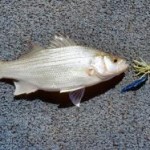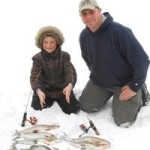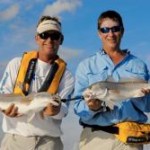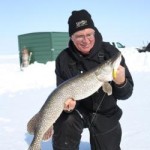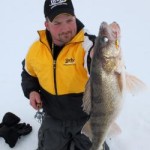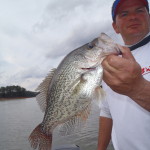Peach State Winter Bass Hotspots
Baby its cold outside. But unlike the song, Georgia bass fishermen don’t want to sit by the fire. Instead, we want to get out on the water and catch some fish. We are lucky because there are some excellent places to catch winter bass here.
From the southern border with Florida where some bass often start fanning beds in January to the North Georgia mountains where spotted bass gorge themselves in the coldest water, good fishing is available. Some middle Georgia lakes have a mixture of spots and largemouth and others have special patterns that pay off now. Pick a lake close to you or drive a ways to find some good winter bass action.
Seminole
Pam Martin-Wells has won more money on the bass trails than any other woman and was recently inducted into the Legends of the Outdoors Hall of Fame. She grew up on the Flint River at Lake Seminole and guides there when not on the tour. She knows the lake well and keeps up with what the bass are doing.
For winter fishing on Seminole Pam heads to Spring Creek. The water there usually stays clear and that helps in cold water. It also warms quickly, pulling bass up toward the spawning flats early. With standing timber everywhere in the creek they have good places to hold and the hydrilla beds offer perfect cover for them.
To find winter bass Pam would start near where the Wingate cut-through hits the Spring Creek channel. She gets on the edge of the old creek channel and follows it as it winds its way across the timber filled flats. Remember that the channel does not follow the boat channels. It winds and loops through the timber.
As you ease along the channel watching your depthfinder you can usually see the hydrilla edges. The hydrilla grows on the flats along the channel but the channel itself is too deep for it. So you are fishing the channel drop, timber that is on the edge of the channel and hydrilla edges along the channel. All combine to make excellent bass “highways” that they follow and hold on.
Pam fishes the channel from the cut-through all the way out to the main lake. Outside bends are best and the ones that turn right where a ditch runs up on a spawning flat are excellent. If the outside bend is near the flat it is good but a ditch for the bass to follow makes it even better.
A big crankbait like a Fat Free Shad is the bait Pam uses to find fish in the cold water. She keeps her boat in the creek channel and makes casts that parallel the edge of the hydrilla. Crank the bait down then work it fairly fast along the edges where the bass are holding. Trilene Big Game line is tough enough to pull big bass out of the hydrilla so that is the line she chooses.
If the bass don’t want to chase a crankbait or if Pam hits a school of fish and they quit biting, she picks up a Wave Worm Tiki Stick. She rigs it both Carolina and Texas style and fishes it along the edge of the channel, too. She prefers a Tru-Tungsten sinker because it is denser than lead and she can use a smaller size weight. The smaller size comes through the grass better. That weight also gives her better feel because of its density.
A cold front really puts the bass at Seminole down. Try to plan your trip during a warming spell. If there have been two or three days of relative warm, stable weather the bass fishing should be excellent.
Lake Harding
Robert Medas and Kevin Phillips grew up together near LaGrange and have fished the area together for several years. They joined the West Georgia Bass Club and have done well in this competitive team trail club. Their tournaments often put 50 to 70 boats on the water. In 2007 there were 163 teams in the club.
In 2005, their first year in the club, Robert and Kevin placed 4th in point standings for the year then followed it up with a first place finish overall in 2006. In 2007 they started out the year with a win at West Point in January and were in 8th place overall after 9 of the 12 annual tournaments.
Lake Harding, also called Bartletts Ferry, is a good winter time lake for them. It has varied cover and structure that gives them a choice of kinds of places to fish based on the weather and other conditions. And the lake has a big population of spotted bass. Spots tend to feed better in cold water and are less affected by cold fronts than are there largemouth cousins.
Another reason Harding is a good winter choice is the stability of the water. Since it is just downstream of West Point the water level stays fairly constant. There are areas of the lake that seldom muddy up, another big plus in cold water.
In cold water the bass at largemouth at Harding are usually holding in deep brush waiting on passing schools of shad. Spots are more likely to be found around rocks on points. For both species Robert and Kevin team up by throwing different baits, with one fishing faster moving crankbaits and spinnerbaits while the other works a jig and pig or jig head worm.
Halawakee Creek is a good choice for winter fishing. Although it is on the Alabama side of the lake a Georgia fishing license is good there. This creek stays fairly clear all winter and you can find any kind of cover and structure you want to fish.
Work up the creek, hitting rocky points for spots. Run small crankbaits and spinnerbaits over the rocks and work a jig and pig or a jig head worm on them. Fish from 8 to 18 feet deep. You can hop from point to point as you fish up the creek, concentrating on the rocky ones.
For largemouth look for brush piles down 12 to 18 feet deep. Many docks have brush around them and some of the feeder creeks have good brush on the channel. Also pay attention to steep banks where blowdowns have fallen into the water. The creek above the second bridge is a very good area for this kind of cover.
There are also a good many humps and channel ledges in open water in Halawakee Creek. Most maps don’t show them so watch your depthfinder as you ride the middle of the creek. There are good humps and channel drops from the mouth of the creek to the first bridge. Long points also extend way out from the bank.
On the ends of these points and on humps and channel drops Robert and Kevin like to jig a spoon. Locate fish and bait near the bottom in 18 feet of water, position your boat right on top of them and drop a jigging spoon like a Hopkins down to them. Work it up and down in one place and be ready to set the hook on the fall.
Clarks Hill
I grew up in McDuffie County, went to high school in Thomson and started fishing Clark’s Hill in the 1950s. My family has had a place on the lake since the mid 1960s and for many years I spent the last two weeks of December fishing there. Winter has always been one of my favorite times to fish the lake and some of the patterns I have found pay off every year from late December all winter long.
When the water gets cold the bass stack up on the ends of long, shallow points on the Georgia Little River side of the lake. I especially like the area around Germany Creek since I have a place at Raysville Boat Club and fish there the most. There are many shallow points and ridges on the river and the creeks in that area that hold winter bass.
Ride the channels watching for a point, hump or ridge coming up to about 12 feet deep. A hard clay or sand bottom is best and rock or gravel makes it even better. Watch your depthfinder for schools of baitfish nearby and marks of fish near the bottom under them.
Starting at 12 feet deep jig a Little George or spoon like the Hopkins in the fish you see. Stay right on top of them and move it up and down in one place. Start with short hops, raising your rod tip about a foot and letting the bait fall on a tight line. Gradually make higher and higher hops until the fish show you what they want. At times you will need to raise your rod tip three to four feet, making the lure rise that far off the bottom before falling back.
Be ready for a tick as the bait falls and set the hook when you feel it, or if the bait does not fall all the way back to the bottom. When using the Little George you should be able to feel the tail spinner moving as you raise and lower the bait and if you feel it stop spinning set the hook.
Work deeper and deeper, especially if the water is clear. Most of the bass I have caught have been 12 to 15 feet deep in stained water and the Little George works better in stained to muddy water. The deepest I have ever caught a bass doing this was 57 feet deep in Grays Creek. I was jigging a Hopkins Shorty spoon straight under the trolling motor and the water was fairly clear, so keep working deeper until you find the fish.
Bass also stack up in ditches this time of year at Clarks Hill and a Zoom Fluke fished in them on a jig head is and excellent way to catch good fish. Put your boat in 30 feet of water anywhere a ditch enters the main lake and make long casts down the center of it. Swim the bait just off the bottom and set the hook if you feel any weight.
If the steady movement doesn’t work try hopping the jig and Fluke back. Hop it a foot off the bottom and let if fall back. Work all the way out to the boat, fishing water from a few feet deep to 30 feet deep down the center of ditches and depressions. You will often find a school of bass and catch several in one place doing this.
Lake Burton
Daniel Workman has worked on boats in the Burton area for several years and fishes the lake a lot. He enters pot tournaments there and has also fished with some area clubs. His best catch in a tournament on the lake was a five fish limit weighing 22 pounds and he has landed a six pound spot there.
Burton produces big spots and they feed good in cold water. Blueback herring in the lake have made it a great place for big spotted bass . The state record 8 pound, 2 ounce spot was caught at Burton in February. Winter is a good time to fish for spots on the lake and you might catch some good largemouth, too.
Daniel says the spots school up on deep points and humps and follow the herring during the winter on Burton. To find the bass you first find herring then go to nearby humps and points that top out 15 to 22 feet deep. Cover like brush or rock on the top will help hold the bass.
The lake is small enough you can fish most of it in one day but Daniel concentrates on the lower end, usually fishing from the area around Murray Cove down to the dam. The water stays clear here and cold water fishing is better in the deeper, clearer water.
A variety of baits work well for big Burton spots in cold weather. A jerkbait is excellent if the water is clear and it usually is. Make a long cast across a point or hump and crank the bait down, then work it back with a jerk then a long pause. The colder the water the longer the pause should be. A bait that suspends, like the Lucky Craft Pointer, is very good for this kind of fishing.
Spots will come up from deeper water to hit the jerkbait. Try different cadences with it. Sometimes a jerk-pause-jerk works but try a jerk-jerk-pause, too. Vary the action of the bait until the bass tell you what they want.
If a jerkbait is not working Daniel will throw a big crankbait like a big Fat Free Shad in shad color. He makes long casts across the structure with it and cranks it back with a steady speed, keeping it down as deep as possible.
Plastics are good, too. Texas, Carolina and jig head rigged worms will all catch Burton bass. A Zoom green pumpkin Finesse worm with the tail dyed chartreuse with JJ’s Magic to add scent and color is his choice for all of the rigs. Daniel fishes the Texas rig through brush but likes the jig head better on a clean bottom.
Work the plastic bait through cover on deep points and humps when the fish are not active. Try all three rigs since some days the fish seem to prefer one over the other. Fish the Texas and jig head worms on fairly light line and use a lighter leader on your Carolina rig in the clear water.
Some bass fishermen stay at home this time of year because of the cold. There is no reason for that with the kinds of clothing available to fishermen now. Dress warmly in layers and top it off with a snowmobile suit or other cold weather gear and you can stay relatively comfortable.
A few tricks really help you stay warm. Wear a hood over your head that covers your neck and keeps neck and head warm. That makes a lot of difference. The bass fisherman’s traditional baseball cap is not a good choice this time of year, unless you have a stocking cap pulled down over it and a hood over both.
Another good trick is to fill your pockets with handwarmers. The chemical type are cheap and easy to use, and most will last all day. Put two tiny ones in your boots, a couple in pants and shirt pockets and keep one in each jacket pocket to thaw your hands and you can keep on fishing.
Don’t sit at home and complain about the cold. Dress warmly and try one of these lakes for good winter action. You have a choice in the types of waters you want to fish and the kinds of bass you want to catch. But you can’t catch any of them sitting by a fire!
